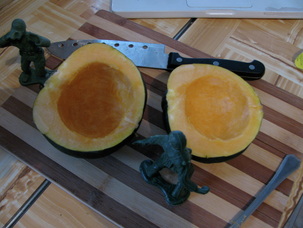
Plant number one in the repertoire: the acorn squash. Seriously nutritious, sweet, and cheap, this plant is easy peasy.
Acorn squash is a great source of potassium, dietary fibre, magnesium and vitamins A, B6 and C. With an average calorie count of 172 and zero fat, this is a dish you can feel good about.
It’s easy on the wallet too. I buy my squash for $1.89 each at my pretentious little grocery store, but have seen them for less than a dollar in the big box stores. What's more, winter squash can be stored in a cool dry place for months. Start a stash and you'll always have something fast and wholesome on hand.
The procedure:
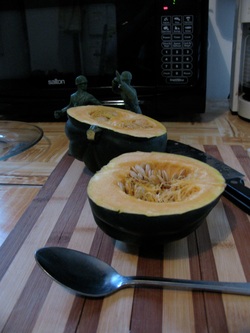
Cooking: This entire process takes about 10 minutes.
1. Clean your squash.
At some farms, the produce will be sprayed with water before it's packed. My squash looks pretty clean so I'm assuming something happened between the field and my table. However, It was probably exposed to chemicals so safety first.
2. After admiring the acorn shape for a while, take a big knife and chop the sucker in half.
3. Scoop the seeds and stringy stuff out until your left with nice orange bowls. You could separate and toast the seeds for a snack, if you felt like it.
4. Now cover the squash and microwave on high for eight to ten minutes. Baking in the oven takes a lot longer, but you can find recipes here.
You could use plastic wrap, like the recipe my squash label suggests, or be a little kinder to the environment by covering with a renewable or non-disposable material. As you can see in the pictures, I covered them with my plate. And that I had help from the troops.
5. When the squash is done it should be tender, and it will be hot. Let it cool for about five minutes and dress it as you please.
Some fancy people stuff the little squash bowls with rice and veggies. Personally, I throw a little butter and brown sugar in there. My friend Mike from Vermont says it's better with maple syrup. Typical.
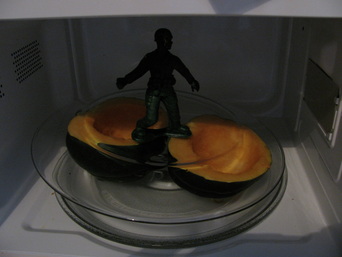
If you're buying squash in Canada, chances are it came from the United States or Mexico. My “Si Señor” brand acorn squash is a product of Mexico, but a large American wholesale produce operation, Al Harrison Company, will profit most from my purchase. Squash need warmer, dryer climates than Canada's, leading us to import about two-thirds of our squash supply.
Growing Acorn squash is pretty simple: wait until the earth is warm, till your soil into little hills about six feet apart, and plunk five or six seeds one inch deep into each hill. Then wait 75 to 90 days until harvest, keeping a watch out for bugs and blight.
Too much water is bad for a squash. During my farm market days, a wet summer meant that by Christmas time matriarchs were battling for the last of the buttercup (the squash we traditionally eat with holiday meals). Fortunately, this year was dry, much to the chagrin of my boyfriend's mother whose storeroom is overflowing.
As Squash grow, long vines stretch out from the seed. Llike many fruit (and squash is technically a fruit) their yellow flowers need to be pollinated. Vibrant male blossoms bloom first, followed by female flowers capable of bearing fruit.
Though my french neighbors would call it courge poivrée, acorn squash is scientifically dubbed Curcurbita Pepo. All squash species are native to North and Central America, and the word “squash” is considered to come from forms of the Algonquin word askutasquash. Apparently squash is sometimes called vegetable marrow by the Brits. Gruesome, right?
The title “acorn squash” didn't appear in print until 1937. It's easy to assume that agricultural products don't go through the same branding process as commodities like dish detergent and toilet paper, but farmers are part of industry too. I found this discovery about as jarring as the revelation that pumpkin pie is usually made out of squash. Lies!
There you have it: the whole story, from field to microwave and beyond. Squash: it’s good tasting, low costing, nutrient packed and more importantly, it's fast and easy.
Thanks for reading! And check back for the next leg of the Mostly Plants cooking quest on February 2nd.
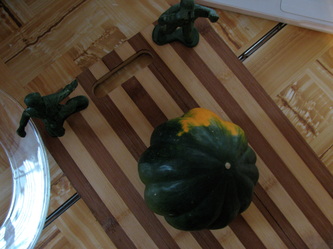
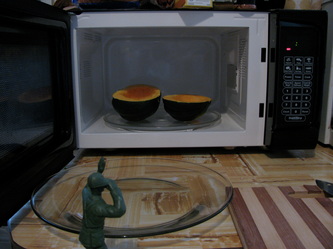
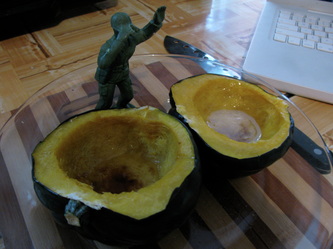
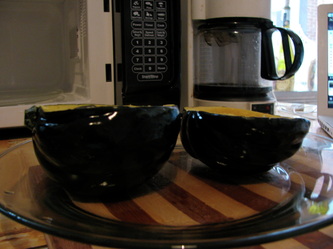
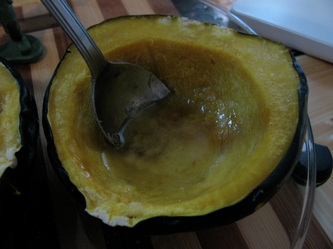

 RSS Feed
RSS Feed